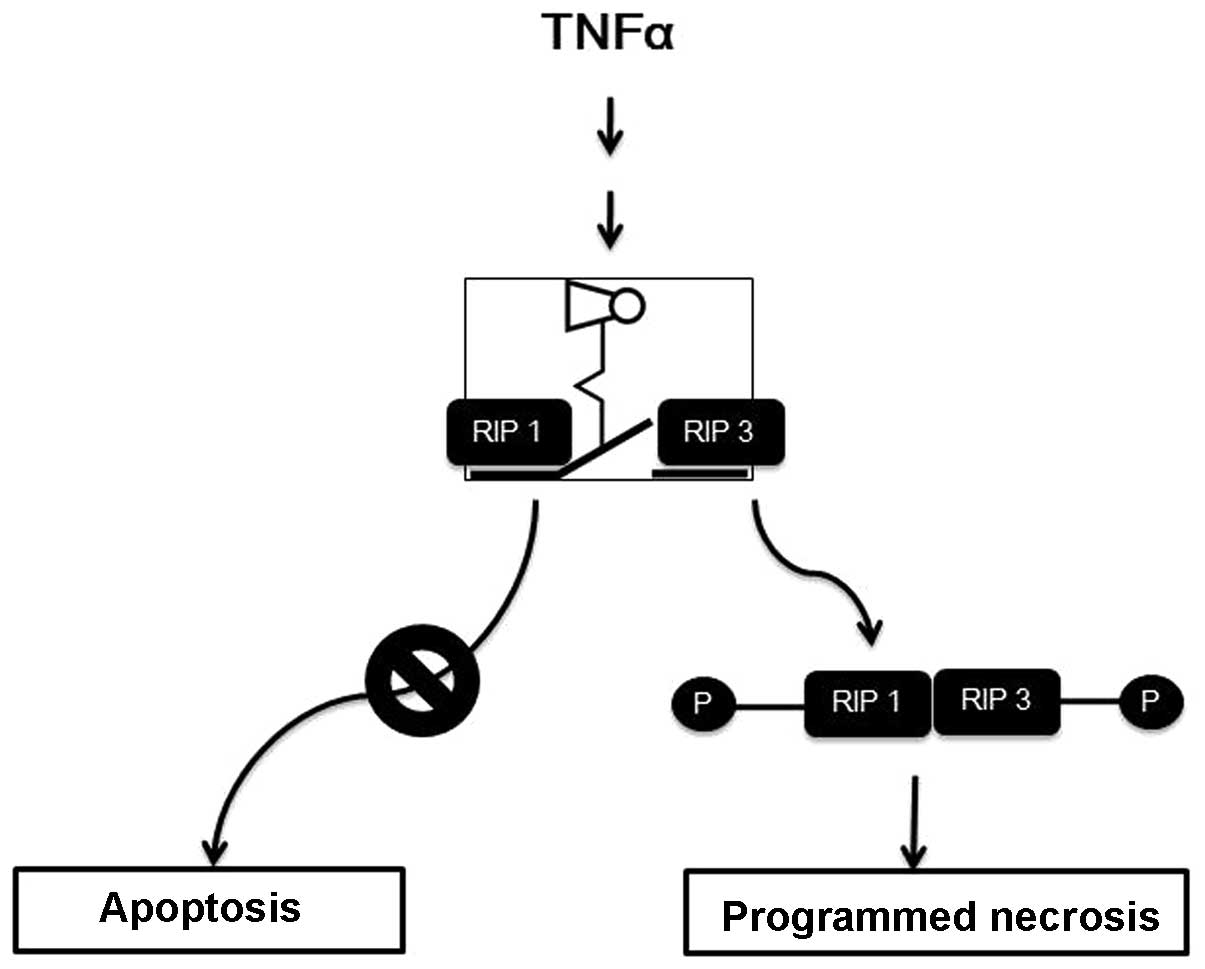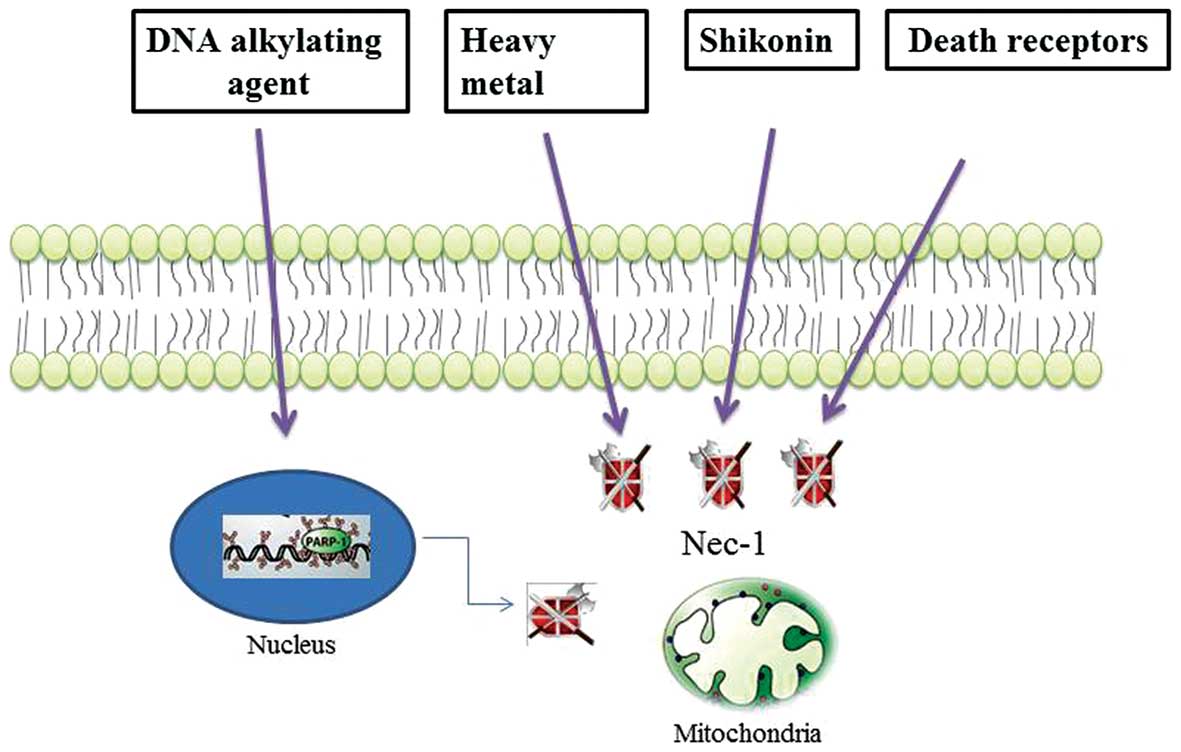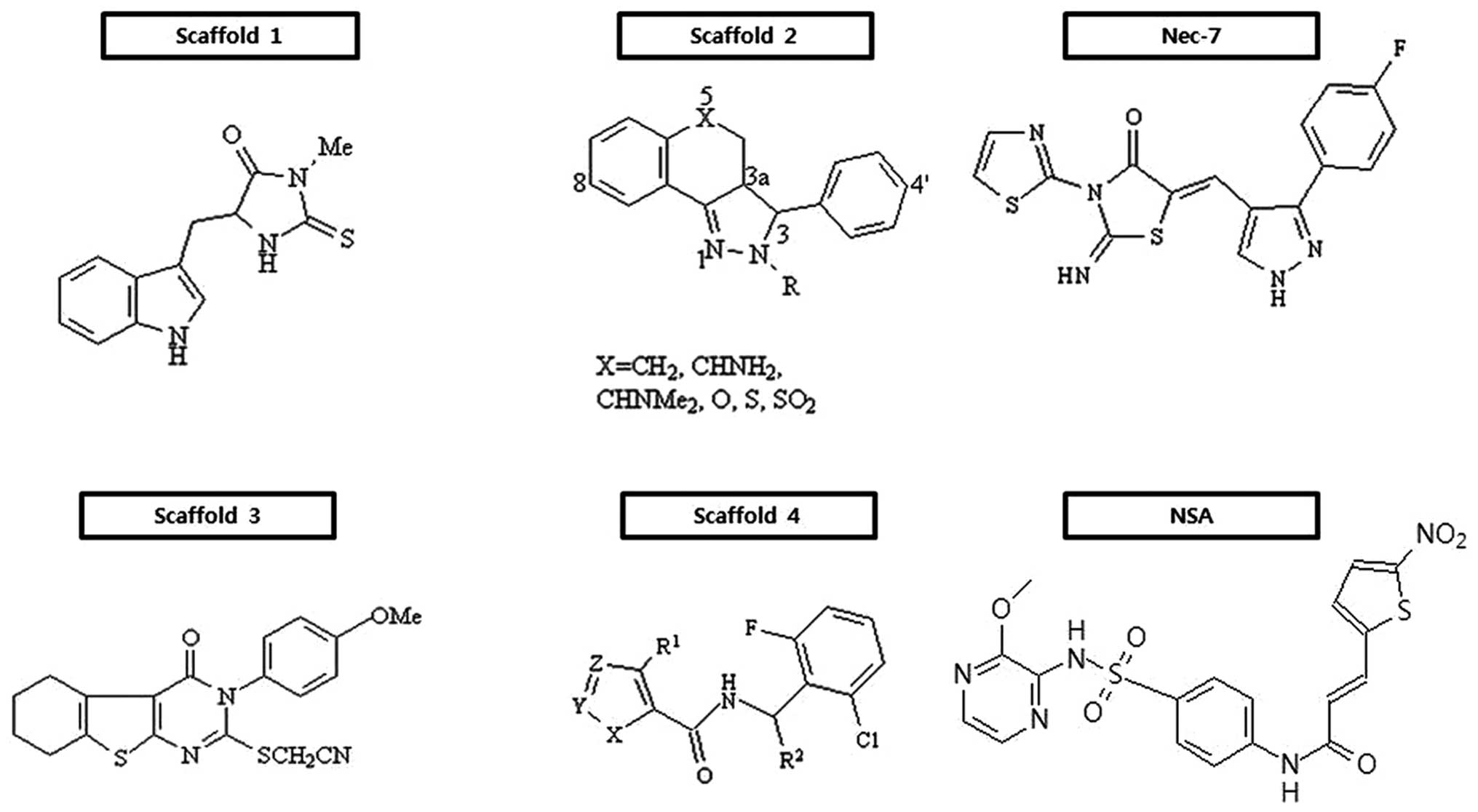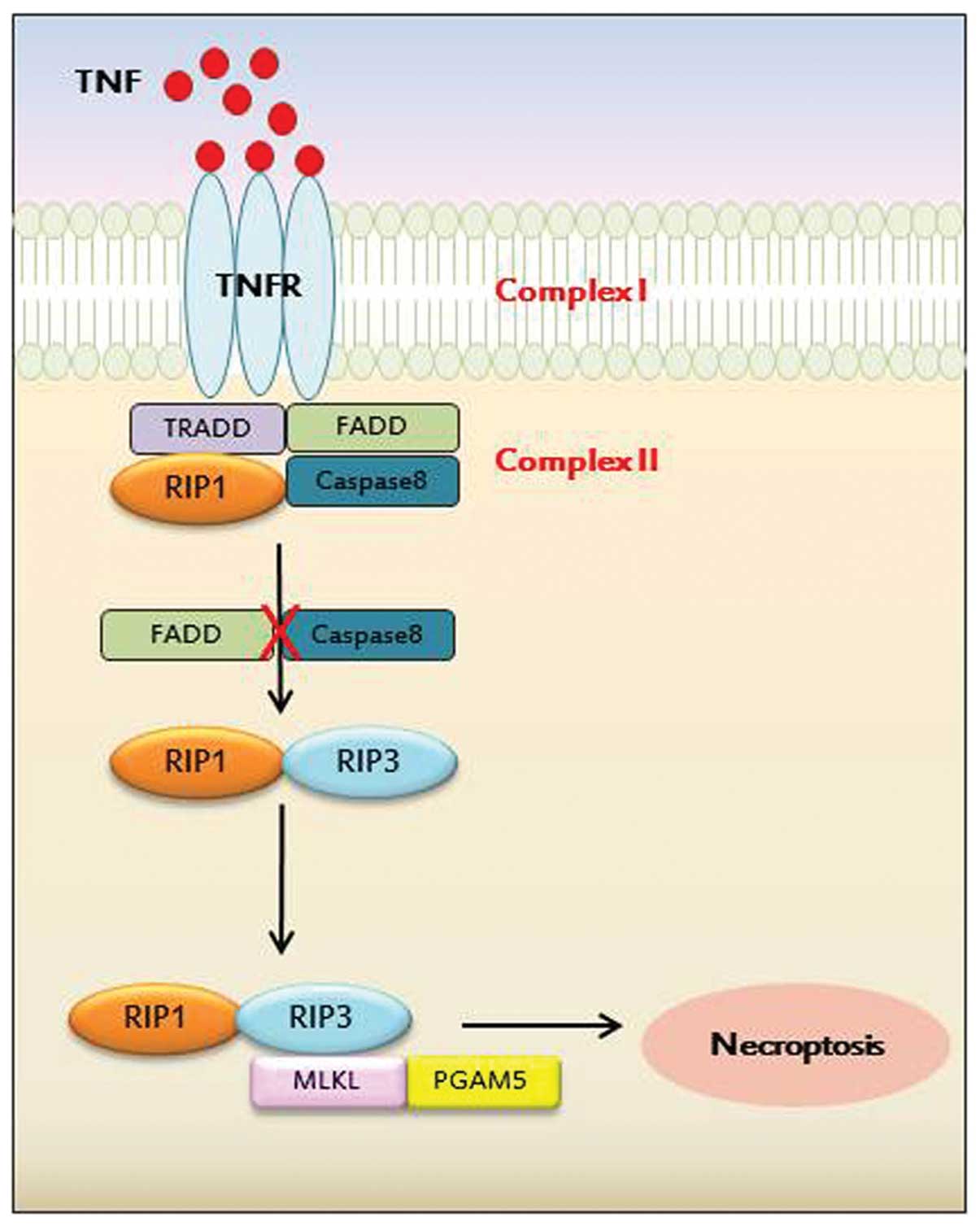Perspectives on the therapeutic modulation of an alternative cell death, programmed necrosis (Review)
- Authors:
- Published online on: March 27, 2014 https://doi.org/10.3892/ijmm.2014.1716
- Pages: 1401-1406
Abstract
1. Overview of programmed necrosis (necroptosis)
Over the past 40 years, apoptosis has been generally thought as the only prototype of programmed cell death. By contrast, another cell demise termed ‘necrosis’ is simply described as a passive and unwanted cell death in response to the overexposure of chemical, physical or radioactive stress. The third cell death mode, autophagy, is not discussed in this review as there is still some controversy as to its role in cell survival and cell death. Based on morphology, biochemistry and physiology, necrotic cell death has unique characteristics, distinct from those of apoptosis and autophagy. Some typical features discriminating between apoptosis and necrosis are listed by criteria in Table I. Of note, the loss of membrane integrity in cells undergoing necrosis induces the release of intracellular debris, referred to as danger signals into the microenvironmental niche, consequentially eliciting inflammatory responses (1). Although little attention has previously been paid to necrotic death, its pathophysiological significance coupled to inflammatory response has recently been emphasized.
Apart form apoptotic stress in nature, there exist a variety of physical, chemical and biological stimuli causing necrosis. These include high energy irradiation, DNA alkylating agents and cytokines (2–4). Of the death stimuli listed above, tumor necrosis factor (TNF)-α is a pleiotropic inflammatory cytokine, and it initiates survival or programmed cell death, apoptosis through the TNF-α receptor and a cascade of downstream executioners (5). However, under specific conditions in which the apoptotic machinery is blocked by a pan-caspase inhibitor (zVAD peptide) or viral infection, the cells themselves redirect the apoptotic cell demise into an alternative cell death (Fig. 1). Since a unified nomenclature on such a backup cell death program has not been withdrawn, it is therefore referred to as necroptosis, programmed necrosis, or caspase-independent cell death. In spite of ambiguous nomenclature, there is a growing body of evidence indicating that programmed necrosis is a backup cell death program that is activated when caspase-driven cell death is blocked (4,6). More precisely, programmed necrosis contributes to N-methyl-D-aspartate (NMDA)-induced excitotoxicity in neurons, as well as heavy metal poisoning and chemical-induced toxicity (7–9). The precise manipulation of cell death modes makes it possible to consequently define a new paradigm of another cell death mode by analyzing the biochemical and molecular parameters. As a result, Hitomi et al demonstrated that a variety of proteins were related to necroptosis through a genome-wide analysis (10). Thereafter, proteins responsible specifically for programmed necrosis have been extensively investigated and consequently, some promising therapeutic proteins are discussed in this review. The identification of some specific programmed necrotic proteins and the development of small molecules specifically targeting receptor interacting protein 1 (RIP1) make it conceivable that necrotic cell death is not only an independent and specialized form of cell death, but that it is also a part of an orchestrated signaling network.
2. Therapeutic target molecules identified for mediating necroptosis
Since necrosis has long been thought to be a passive and unwanted cell response to devastating external stresses, the identification of novel proteins responsible for necrotic death has not been completed. However, accumulating evidence indicates that DNA alkylating agents, shikonin and heavy metals induce programmed necrosis-like cell death, distinct from necrosis or apoptosis (Fig. 2) (11–13). Specifically, DNA alkylation-induced DNA damage is repaired through the activation of poly(ADP-ribose)polymerase-1 (PARP-1), which is a nuclear enzyme that catalyzes the covalent linkage of long branched chains of PAR to a variety of nuclear DNA-binding proteins, including PARP-1 (14,15). However, massive and intolerable DNA damage to cells mediates necrosis through he excessive activation of PARP-1, which depletes the ATP energy supply of the cells supply and subsequently results in metabolic catastrophe (16).
RIP1 was first identified as a regulator of programmed necrosis upon TNFR stimulation (17). The activity of the RIP1 death domain kinase is required for death receptor- and zVAD.fmk-mediated necroptosis in murine and human cells. Later, three individual research groups identified another novel protein, RIP3, as a critical protein for the activation of programmed necrosis when default cell death (apoptosis) is hindered (18–20). Furthermore, it has been demonstrated that the pronecrotic complex formation between RIP1 and RIP3 is required for programmed necrosis, indicating that downstream or upstream signaling networks of the RIP1-RIP3 complex are plausible and can be tightly regulated by a cascade of proteins. It has also been published that the NAD-dependent deacetylase, SIR2, is involved in the regulation of TNF-mediated programmed necrosis (21). It not only recruits RIP3, but also catalyzes the deacetylation of RIP1 to allow it to be in a stable conformation, forming a necrotic complex.
Recently, the mixed lineage kinase domain-like protein (MLKL) was identified as a RIP3 substrate, as well as a biological target of the hit compound against necroptosis by a combined approach of chemical biology and biochemistry (22). Unlike both RIP1 and RIP3 proteins, MLKL does not possess kinase activity due to its absence of a phosphate-binding loop and key amino acids for kinase. However, its binding to RIP3 through kinase-like domain leads to an increased RIP3 kinase activity through the formation of a stable complex. Subsequently, MLKL is phosphorylated as a RIP3 substrate to form a necrosis-inducing signaling complex, termed the necrosome, which includes RIP1, RIP3 and MLKL. In addition, other kinases and metabolism-related proteins have been disclosed by using interference RNAs (18), and are putatively expected to be involved in creating the signaling network of programmed necrosis.
Apart from cytosolic proteins described above, mitochondrial proteins have been suggested to be putative candidates for mediating necroptosis. Pro-death Bcl2 proteins, which have been documented to play a decisive role in the intrinsic apoptotic pathway, have also been suggested to be invovled in necrotic death (23,24). For instance, Bax, Bmf, BNIP3 and Nix are candidate mitochondrial proteins responsible for specific necrotic death. In light of mitochondrial function, cyclophilin-D (CyP-D) and mitochondrial permeability transition (MPT) pore have been gaining attention as the emerging targets to modulate necrosis effectively. Of note, RIP3, being activated by a cascade of events following TNFR ligation, has been suggested to interact with the mitochondrial protein, glutamate dehydrogenase 1 (GLUD1), therefore linking the signaling pathway from extracellular stimulation, intracellular events, to mitochondria. Recently, the signaling downstream of RIP1/RIP3 complex has been extensively explored. Accordingly, the interaction of MLKL with the RIP1/RIP3 complex recruits the mitochondrial protein phosphatase, PGAM5, functioning as the convergent point for multiple necrosis pathways (25).
3. Small molecules that protect cells from programmed necrosis, but not apoptosis
Small molecules that protect cells from undergoing programmed necrosis are listed by scaffold in Fig. 3. Since the introduction of the necroptosis concept to cell demise, the discovery and optimization of small molecules with potent inhibitory activity against it have been pursued for therapeutic use. The first successful outcome is a series of hydantoin compounds containing indole derivatives (Fig. 3, scaffold 1) (25,26), which are potent necrostatins. A structure-activity relationship (SAR) analysis indicated that several positions of the indole moiety were very vulnerable to chemical modification, apart from electron-donating or -withdrawing substituents at the 7-position, and that the hydantoin ring was also very sensitive to structural modifications. In fact, the substitution of the amide nitrogen and removal of a carbonyl group led to a complete loss of activity. Also, steric bulk and extension of the linker between the indole and hydantoin ring are found to be detrimental for their inhibitory activity against necroptosis. Out of this class bearing scaffold 1, a chemical necrostatin-1 (Nec-1) has so modest pharmacokinetic profiles to be delivered to the central nervous system (CNS) following intravenous administration (27). Subsequently, an extensive exploration for target molecules of this scaffold resulted in the identification of RIP1 as an interacting molecule of Nec-1 (28). Mechanistically, Nec-1 inhibits RIP1 in an ATP-competitive manner.
Since then, the discovery of a series of tricyclic derivatives (Fig. 3, scaffold 2) (29) and substituted 3H-thieno[2,3-d]pyrimidin-4-ones (Fig. 3, scaffold 3) (30) were ensued. SAR of scaffold 2 demonstrates that the (3R, 3aR)-rel-diastereomers are more potent than the corresponding (3R, 3aS)-rel-diastereomers. The replacement of fluorine or methoxy at the 8-position of the tricyclic ring enhances the protective activity, whereas that at the 6-, 7- and 9-positions is fatal. Also, the introduction of a methoxy group to the 4-position of the phenyl ring improves activity, while the location of the methoxy at the 2-position of it deteriorates its potency; the placement of amides at the 2-position in the tricyclic ring part shows the best activity. Notably, in contrast to a hydantoin-indole necrostatin, these derivatives do not protect cells from zVAD-induced programmed necrosis in L929 cells, suggesting that there is a mechanistic distinction between the two series of compounds (29). In scaffold 3 (Fig. 3), the thioethylcyanide moiety on the α-position of fused pyrimidone-4 part is required for the inhibition of necroptosis. The presence of the -OMe group in the para-position of the benzene ring bonded to pyrimidone nitrogen is found to be critical for its protective activity. The introduction of aliphatic rings, such as cyclopentyl, cycloheptyl or benzene at the position of thiophene ring exhibits some variable activities. It is apparent that derivatives with the methyl group at the α- and β-position of the thiophene ring exhibit significant activities. With increasing size of the aliphatic ring, their inhibitory activities are detrimental. By contrast, substitution of the phenyl ring for the cyclohexane ring keeps its active. Furthermore, [1,2,3]thiadiazole derivatives (Fig. 3, scaffold 4) drawn through high throughput screening have been found to effectively protect cells from necroptosis (31). Through SAR analysis, it has been demonstrated that secondary 2,6-dihalo substituted benzyl amides are required for their antagonizing effects on necroptosis. When the methyl group is located in the benzylic position, the (S)-enantiomeric configuration has its own ability to interfere with necroptosis. Small branched or cyclic alkyl groups are favorable in the 4-position of [1,2,3] thiadiazole. Of note, the replacement of [1,2,3] thiadiazole with a variety of thiophene derivatives is tolerable. Through the extensive optimization of necrostatins, a novel necrostatin, Nec-7, bearing thiazole exerts differential biological activity from structurally diverse necrostatins, such as Nec-1, Nec-3, Nec-4 and Nec-5 (32). A series of Nec-7 derivatives suppresses TNF-α-induced necroptosis in the FADD-deficient variant of human Jurkat T cells, but have no RIP1 inhibitory activity, suggesting that they may target other necroptosis proteins. SAR analysis showed that various substituents at the phenyl 4-position are essential, that the para-position of the phenyl ring is tolerable to substituents and that the pyrazole ring is susceptible to structural modification (32).
With the discovery of new targets, a hit compound has been identified through the screening a library of 200,000 compounds for chemicals that protect necrosis. The compound, (E)-N-{4-[N-(3-methoxypyrazin-2-yl)sulfamoyl]phenyl}-3-(5-nitrothiophene-2-yl) acrylamide, is commonly referred to as necrosulfonamide (NSA) and has been reported to be more potent than Nec-1, with an IC50 of >1 μM under the necrosis- inducing context. In an effort to reveal its target, MLKL has finally been proven to be a specific target of NSA which can modify covalently the Cys 86 residue within the N-terminal CC domain of MLKL and consequently interfere with the induction of necrosis (22).
Among those scaffolds listed above, scaffold 1 has shown in vivo activity in some mouse models, such as middle artery occlusion (MCAO) (27), ischemic/reperfusion heart injury (33) and traumatic brain injury (TBI) (34). Apart from efforts on the development of necroptosis inhibitors, very little attempts have been made to develop therapeutic drug targeting unregulated cell death, literally necrosis. Recently, LG Life Sciences, Inc. (Seoul, Korea) identified a series of necrosis inhibitors, referred to as NecroX™, which has been of interest for therapeutic candidates of liver diseases and fibrosis, ischemia and neurodegenerative diseases (35). However, it acts specifically as a scavenger of mitochondrial ROS, so that its action mechanism is totally different from that of necroptosis inhibitors. In a study from my group (unpublished data), NecroX™ was not effective against TNF-α-mediated necrosis, thus suggesting that death-causing ROS are differentially derived from death modes.
4. Control of diseases related to programmed necrosis
Physiological outcomes of programmed necrosis during viral infection are of significance as an innate immune defense mechanism. In such a case that viruses or intracellular bacteria encode caspase inhibitors, host cells themselves fail to operate the quality control death program (apoptosis) enough to get rid of infected cells, leading to the propagation of infectious agents. In light of the pathophysiological aspects, however, an alternative cell death to apoptosis may rather induce serious damage to tissues, such as ischemic brain and heart tissue. Nerve cell death occurs in neurodegenerative disorders, with a continuum of apoptosis and necrosis being central to acute and chronic degenerative events (36). In addition, it has been known that chemical-induced pancreatitis is associated with programmed necrosis (37). Clinically, parenchymal necrosis is a key complication of pancreatitis, the severity of which depends on the cell death modes. Conversely, caspase induction protects from necrotizing pancreatitis (38). Sepsis is also thought to be derived from cell death caused by acute uncontrolled microbial infection. For instance, the pore-forming α-toxin from C. septicum triggers a multifaceted necrotic cell death response that is distinctively found in myonecrosis and sepsis (39). However, the detailed process by which cell death is linked to pathogenic outcomes remains elusive; programmed necrosis but not apoptosis may provide some insight into its pathogenesis. Decisively, Nec-1 can significantly delay the brain necrotic lesions induced by arterial occlusion, implying clearly that there occurs necrotic cell death controlled by RIP1-specific inhibitor in an ischemic setting. There is a growing need that a series of novel small molecules be developed to treat inflammatory-related diseases mentioned above. This may rather be based on the programmed necrosis-targeting strategy beyond an effective suppression of apoptosis. In fact, under an ischemic condition, the penumbra of the injured brain are the battle ground for stroke treatment, and immediate action should be taken for treatment by restoring perfusion to the ischemic area (40). Accordingly, there is at least an urgent need to develop safe and potent neuroprotective drugs that can mitigate the damage of cells in the penumbra shortly after onset and prior to hospital arrival.
A new paradigm of cell death makes it difficult to delineate cell damage inflicted by extracellular stimuli, whether it may be derived from microbial infection or chemotherapy. Although it is not generally admitted, imatinib has been suggested to induce cell death through a mixture of necrotic and apoptotic death. Thus, it may be meaningful to address which type of cell death will have a physiological effect over a treatment period.
5. Conclusions
In this review, the backup form of cell death to apoptosis has on its own significant meaning in biology. Cells cope actively with TNF-α-mediated cell death and consequently divert an apoptotic force into an alternative one. More significantly, the switch of death modes such as this have differential effects on physiological outcomes according to the stimuli and tissue niche. In this review, inflammatory diseases associated with programmed necrosis were briefly discussed to demonstrate the identification of small molecules against necroptosis. A variety of efforts in the search for chemical entities have been made since the first identification of RIP1. Presently, Nec-1 is the only small molecule being developed for targeting a specific molecule, RIP1. Thereafter, some necrotic proteins have been extensively explored and signaling networks between molecules have been partly unveiled. The identification of a novel programmed necrosis regulator, RIP3, and elucidation of its signaling pathway will set out to adopt new strategies, such as the suppression of RIP3 kinase activity or the dissociation of the pronecrotic RIP1-RIP3 complex (Fig. 4). Therefore, the discovery of novel small molecules which specifically and selectively inhibit RIP1 or RIP3 will not only clearly elucidate its molecular mechanisms, but may further translate into drug development pipelines. Taken together, this review provides insight into the molecular entity of small molecules against therapeutic target proteins governing programmed necrosis.
Acknowledgements
This research was supported by the college of pharmacy-specialized research fund (the Institute for New Drug Development) of Keimyung University in 2012, and the Basic Science Research Program through the National Research Foundation of Korea (NRF) funded by the Ministry of Education (2013R1A1A2010212).
References
|
Iyer SS, Pulskens WP, Sadler JJ, et al: Necrotic cells trigger a sterile inflammatory response through the Nlrp3 inflammasome. Proc Natl Acad Sci USA. 106:20388–20393. 2009. View Article : Google Scholar : PubMed/NCBI | |
|
Xu Y, Huang S, Liu ZG and Han J: Poly(ADP-ribose) polymerase-1 signaling to mitochondria in necrotic cell death requires RIP1/TRAF2-mediated JNK1 activation. J Biol Chem. 281:8788–8795. 2006. View Article : Google Scholar : PubMed/NCBI | |
|
Petit F, Arnoult D, Viollet L and Estaquier J: Intrinsic and extrinsic pathways signaling during HIV-1 mediated cell death. Biochimie. 85:795–811. 2003. View Article : Google Scholar : PubMed/NCBI | |
|
Cho YS, Park SY, Shin HS and Chan FK: Physiological consequences of programmed necrosis, an alternative form of cell demise. Mol Cells. 29:327–332. 2010. View Article : Google Scholar : PubMed/NCBI | |
|
Rangamani P and Sirovich L: Survival and apoptotic pathways initiated by TNF-α: modeling and predictions. Biotechnol Bioeng. 97:1216–1229. 2007. | |
|
Lamkanfi M, Festjens N, Declercq W, Vanden Berghe T and Vandenabeele P: Caspases in cell survival, proliferation and differentiation. Cell Death Differ. 14:44–55. 2007. View Article : Google Scholar : PubMed/NCBI | |
|
Li Y, Yang X, Ma C, Qiao J and Zhang C: Necroptosis contributes to the NMDA-induced excitotoxicity in rat’s cultured cortical neurons. Neurosci Lett. 447:120–123. 2008.PubMed/NCBI | |
|
Scholz C, Wieder T, Stärck L, et al: Arsenic trioxide triggers a regulated form of caspase-independent necrotic cell death via the mitochondrial death pathway. Oncogene. 24:1904–1913. 2005. View Article : Google Scholar : PubMed/NCBI | |
|
Krumschnabel G, Ebner HL, Hess MW and Villunger A: Apoptosis and necroptosis are induced in rainbow trout cell lines exposed to cadmium. Aquat Toxicol. 99:73–85. 2010. View Article : Google Scholar : PubMed/NCBI | |
|
Hitomi J, Christofferson DE, Ng A, et al: Identification of a molecular signaling network that regulates a cellular necrotic cell death pathway. Cell. 135:1311–1323. 2008. View Article : Google Scholar : PubMed/NCBI | |
|
Baritaud M, Cabon L, Delavallée L, et al: AIF-mediated caspase-independent necroptosis requires ATM and DNA-PK-induced histone H2AX Ser139 phosphorylation. Cell Death Dis. 3:e3902012. View Article : Google Scholar : PubMed/NCBI | |
|
Park S, Shin H and Cho Y: Shikonin induces programmed necrosis-like cell death through the formation of receptor interacting protein 1 and 3 complex. Food Chem Toxicol. 55:36–41. 2013. View Article : Google Scholar : PubMed/NCBI | |
|
Hsu TS, Yang PM, Tsai JS and Lin LY: Attenuation of cadmium-induced necrotic cell death by necrostatin-1: potential necrostatin-1 acting sites. Toxicol Appl Pharmacol. 235:153–162. 2009. View Article : Google Scholar : PubMed/NCBI | |
|
De Murcia G, Schreiber V, Molinete M, et al: Structure and function of poly(ADP-ribose) polymerase. Mol Cell Biochem. 138:15–24. 1994. | |
|
Lautier D, Lagueux J, Thibodeau J, Ménard L and Poirier GG: Molecular and biochemical features of poly (ADP-ribose) metabolism. Mol Cell Biochem. 122:171–193. 1993. View Article : Google Scholar | |
|
Gobeil S, Boucher CC, Nadeau D and Poirier GG: Characterization of the necrotic cleavage of poly(ADP-ribose) polymerase (PARP-1): implication of lysosomal proteases. Cell Death Differ. 8:588–594. 2001. View Article : Google Scholar : PubMed/NCBI | |
|
Holler N, Zaru R, Micheau O, et al: Fas triggers an alternative, caspase-8-independent cell death pathway using the kinase RIP as effector molecule. Nat Immunol. 1:489–495. 2000. View Article : Google Scholar : PubMed/NCBI | |
|
Cho YS, Challa S, Moquin D, et al: Phosphorylation-driven assembly of the RIP1-RIP3 complex regulates programmed necrosis and virus-induced inflammation. Cell. 137:1112–1123. 2009. View Article : Google Scholar : PubMed/NCBI | |
|
He S, Wang L, Miao L, et al: Receptor interacting protein kinase-3 determines cellular necrotic response to TNF-α. Cell. 137:1100–1111. 2009.PubMed/NCBI | |
|
Zhang DW, Shao J, Lin J, et al: RIP3, an energy metabolism regulator that switches TNF-induced cell death from apoptosis to necrosis. Science. 325:332–336. 2009. View Article : Google Scholar : PubMed/NCBI | |
|
Narayan N, Lee IH, Borenstein R, et al: The NAD-dependent deacetylase SIRT2 is required for programmed necrosis. Nature. 492:199–204. 2012. View Article : Google Scholar : PubMed/NCBI | |
|
Sun L, Wang H, Wang Z, et al: Mixed lineage kinase domain-like protein mediates necrosis signaling downstream of RIP3 kinase. Cell. 148:213–227. 2012. View Article : Google Scholar : PubMed/NCBI | |
|
Galluzzi L and Kroemer G: Necroptosis: a specialized pathway of programmed necrosis. Cell. 135:1161–1163. 2008. View Article : Google Scholar : PubMed/NCBI | |
|
Baines CP: Role of the mitochondrion in programmed necrosis. Front Physiol. 1:1562010. View Article : Google Scholar : PubMed/NCBI | |
|
Wang Z, Jiang H, Chen S, Du F and Wang X: The mitochondrial phosphatase PGAM5 functions at the convergence point of multiple necrotic death pathways. Cell. 148:228–243. 2012. View Article : Google Scholar : PubMed/NCBI | |
|
Teng X, Degterev A, Jagtap P, et al: Structure-activity relationship study of novel necroptosis inhibitors. Bioorg Med Chem Lett. 15:5039–5044. 2005. View Article : Google Scholar : PubMed/NCBI | |
|
Degterev A, Huang Z, Boyce M, et al: Chemical inhibitor of nonapoptotic cell death with therapeutic potential for ischemic brain injury. Nat Chem Biol. 1:112–119. 2005. View Article : Google Scholar : PubMed/NCBI | |
|
Degterev A, Hitomi J, Germscheid M, et al: Identification of RIP1 kinase as a specific cellular target of necrostatins. Nat Chem Biol. 4:313–321. 2008. View Article : Google Scholar : PubMed/NCBI | |
|
Jagtap PG, Degterev A, Choi S, Keys H, Yuan J and Cuny GD: Structure-activity relationship study of tricyclic necroptosis inhibitors. J Med Chem. 50:1886–1895. 2007. View Article : Google Scholar : PubMed/NCBI | |
|
Wang K, Li J, Degterev A, Hsu E, Yuan J and Yuan C: Structure-activity relationship analysis of a novel necroptosis inhibitor, necrostatin-5. Bioorg Med Chem Lett. 17:1455–1465. 2007. View Article : Google Scholar : PubMed/NCBI | |
|
Teng X, Keys H, Jeevanandam A, et al: Structure-activity relationship study of [1,2,3]thiadiazole necroptosis inhibitors. Bioorg Med Chem Lett. 17:6836–6840. 2007. | |
|
Zheng W, Degterev A, Hsu E, Yuan J and Yuan C: Structure-activity relationship study of a novel necroptosis inhibitor, necrostatin-7. Bioorg Med Chem Lett. 18:4932–4935. 2008. View Article : Google Scholar : PubMed/NCBI | |
|
Smith CC, Davidson SM, Lim SY, Simpkin JC, Hothersall JS and Yellon DM: Necrostatin: a potentially novel cardioprotective agent? Cardiovasc Drugs Ther. 21:227–233. 2007. View Article : Google Scholar : PubMed/NCBI | |
|
You Z, Yang J, Takahashi K, et al: Reduced tissue damage and improved recovery of motor function after traumatic brain injury in mice deficient in complement component C4. J Cereb Blood Flow Metab. 27:1954–1964. 2007. View Article : Google Scholar : PubMed/NCBI | |
|
Choi JM, Park KM, Kim SH, et al: Effect of necrosis modulator necrox-7 on hepatic ischemia-reperfusion injury in beagle dogs. Transplant Proc. 42:3414–3421. 2010. View Article : Google Scholar : PubMed/NCBI | |
|
Gorman AM: Neuronal cell death in neurodegenerative diseases: recurring themes around protein handling. J Cell Mol Med. 12:2263–2280. 2008. View Article : Google Scholar : PubMed/NCBI | |
|
Gukovskaya AS, Mareninova OA, Odinokova IV, et al: Cell death in pancreatitis: effects of alcohol. J Gastroenterol Hepatol. 21(Suppl 3): S10–S13. 2006. View Article : Google Scholar | |
|
Mareninova OA, Sung KF, Hong P, et al: Cell death in pancreatitis: caspases protect from necrotizing pancreatitis. J Biol Chem. 281:3370–3381. 2006. View Article : Google Scholar : PubMed/NCBI | |
|
Kennedy CL, Smith DJ, Lyras D, Chakravorty A and Rood JI: Programmed cellular necrosis mediated by the pore-forming α-toxin from clostridium septicum. PLoS Pathog. 5:e10005162009. | |
|
Yuan J: Neuroprotective strategies targeting apoptotic and necrotic cell death for stroke. Apoptosis. 14:469–477. 2009. View Article : Google Scholar : PubMed/NCBI |













